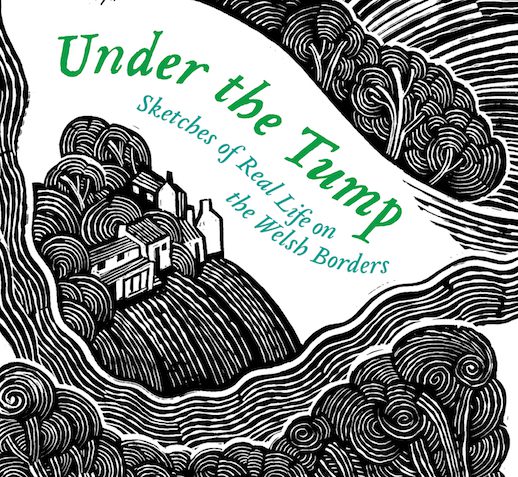Under the Tump: Sketches of Real Life on the Welsh Borders by Oliver Balch
Faber & Faber, 320 pages, hardback. Out now.
Review by Dan Richards.
Meads where for hay the clover grows,
Corn-fields which hedges trim enclose,
A mill a rushing brook upon,
And pigeon tower fram’d of stone.
— Iolo Goch
Under The Tump records how Oliver Balch and his family moved from Buenos Aires to the village of Clyro, just outside Hay-on-Wye, and renovated an old worker’s cottage in the lee of the Black Mountains, opposite a wooded hillock once a fortified castle mound — the tump of the book’s title.
Now part of Powys, the area was known as Radnorshire — an undulating moorland county whose western half drains into the Wye: rade-nore, Anglo Saxon for ‘the land of mountain tracks’ and indeed the book records Oliver Balch’s attempts to make his way in the local community, the challenge of pitching up as an ‘incomer’ to a world where people are so rooted.
The young farmer, Woko, whose family go back into the country; steeped and synonymous within landscape; symbiotic green men — The Watkins, a distinct people who’ve been shaped and shaping a specific part of Wales for centuries.
Early on, Balch aligns himself with another gently curious Clyro interloper, Victorian diarist and curate Francis Kilvert whose diaries, capturing village life on the wing, reveling in the natural world he witnessed, walked and explored on his rounds, proved a sensation when rediscovered and published in the 30s.
VS Pritchett noted at the time that Kilvert’s eye and ear seeming always ‘to be roving over the scene and to hit upon some sight or word which is all the more decisive for having the air of accident’ comparing him to Hopkins and Proust.
‘For some time,’ Kilvert remarked in 1874, with self-conscious artistry, ‘I have been trying to find the right word for the shimmering, glancing, tumbling movement of the poplar leaves in the sun and wind. It was ‘dazzle’. The dazzle of the poplars.’
The extracts of the diary which appear throughout Under The Tump, hark back happily to a world now past — although Balch spends a lot of time juxtaposing and superimposing Kilvert’s then to his now. In this regard the author is something of the anthropologist, a kind of Studs Terkel of the borders — he roves and he listens, he interviews and questions, all the time finding his feet and making friends. The locals eye him quizzically at first but slowly warm and open up.
So the weekly Wednesday nights at the The Rhydspence Inn become important spaces of communal recall, generous transportive portals into a lost world which serve to lengthen the author’s perspective — ‘Everything begins to take on a fraction more depth. Shadows appear. My vision becomes more layered.’
Digging down through the surface like the lino-cut of the book’s cover, Balch burrows like the rabbits who hem the plowed fields around his home, scratches like the fretful game birds, and ponders like a socially anxious badger in a den. Down he goes into a palimpsest of time, people, archives and the Welsh earth itself — surnames, road names, landmark, hill and tree names, villages and farms — multiple narratives, perspectives, eyes, times and minds — folding back over and around each other, the ancient and the new, always returning to author’s status as an ‘incomer’ — the outsider, the spectator who sees more of the game.
Like Kilvert, Balch has a gift for sketching the natural world around him with a marvellous dynamism and flare. Under The Tump is brimful with images, asides and reflections on the natural world and these brilliant moments make up for the author’s occasionally circuitous, repetitious accounts of his attempts to get to grips with his new life and neighbours.
The sculptor David Nash, resident of Bleanau Ffestiniog, once told me that roads and rivers lose all sense of urgency once they cross the boarder into Wales. The country behaves and thinks differently to England, he said, because the Celts were a brilliant and lyrical people who didn’t think in Germanic straight lines.
So perhaps it is apt that, in the end, it is the idiosyncrasy of this book — the unique personality of the country and people around Hay — which set it apart. The voices and stories that Balch teases out by his slow-drip easy conversational approach returns a treasure of wisdom, humour and anecdote which serve to illuminate and elucidate the Welsh landscape and the people within it with great wit and striking beauty.
‘Under the Tump: Sketches of Real Life on the Welsh Borders’ by Oliver Balch, published by Faber & Faber, is out now and available in the Caught by the River shop.
Dan’s latest book, Climbing Days, an exploration of the writing and climbing lives of his great great aunt and uncle – Dorothy Pilley and I. A. Richards – is published by Faber on 16 June. Pre-order a copy from the Caught by the River shop for the special price of £14.99.
